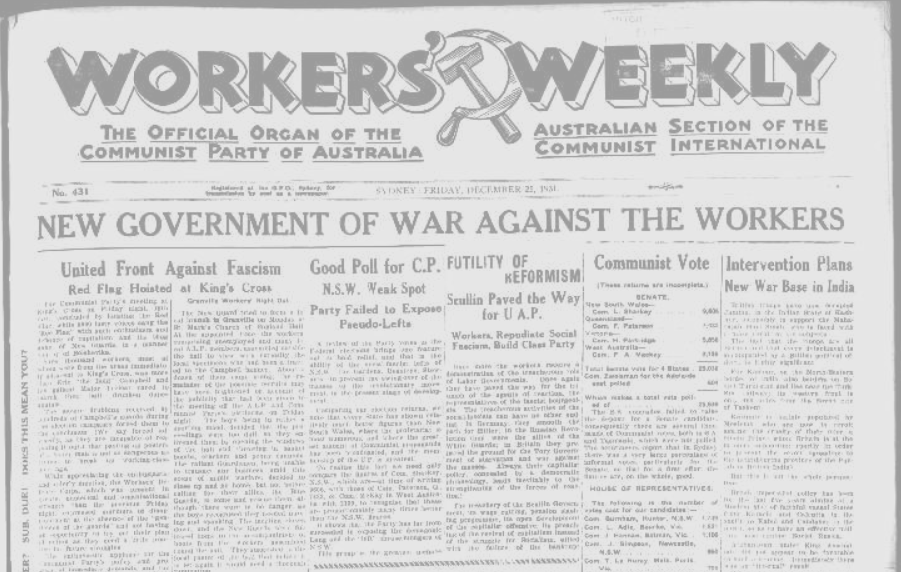
It had been a good year. Summing up in December, the journalist Jean Devanny was content and optimistic:
Our paper is the forerunner of an Australian Pravda. Pravda reflects the history of the Russian Revolution. The same will apply to our paper in the coming time when we, too, like our Soviet comrades have crossed the Rubicon dividing us from beautiful free life.
Even as she watched, between July 1937 and November 1938, as many as 800,000 of her Soviet comrades were shot and 1.5 million condemned to forced labour in Gulag camps, and all that time she and the Workers’ Weekly, the newspaper she wrote for, would cheer on the executioners and guards who selected the victims, fired the bullets or worked their slaves to death. On the other side of the Rubicon Devanny dreamed of jumping across lay the land of the Great Terror.
This essay appears in the latest Quadrant.
Click here to subscribe
In Vasily Grossman’s Life and Fate, his great novel of the German invasion of the Soviet Union, the year 1937 appears over fifty times: the cicatrix of an unhealed wound. Each intrusion of 1937 is a story. One is of a former chekist who had become, in 1942, a prisoner in the Lubyanka:
He told how, in 1937, they had executed people sentenced without right of correspondence every night. The chimneys of the Moscow crematoria had sent up clouds of smoke into the night, and the members of the Communist youth organization enlisted to help with the executions and subsequent disposal of the bodies had gone mad.
It was the Stalinist state that was madder than any fiction.
The Workers’ Weekly was an anorexic four-page newspaper published by the Communist Party of Australia. It was issued, with Left logic, twice weekly, on Tuesdays and Fridays—in 1939 it became the Tribune of sad memory: they once published a poem I wrote.
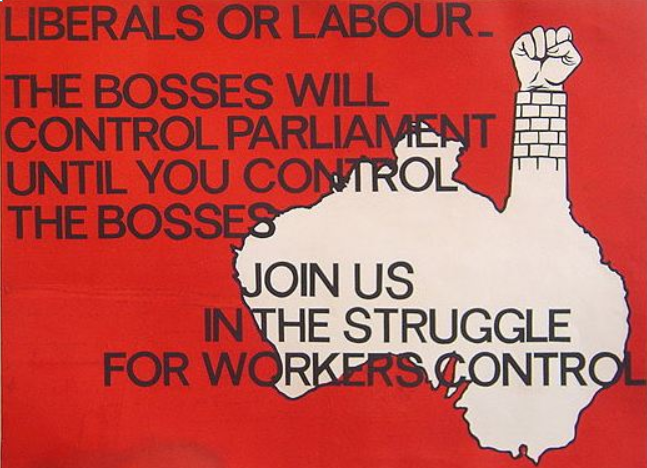
In 1937 the newspaper followed the Spanish Civil War, Japanese atrocities in invaded China, a federal election (Joe Lyons and the United Australia–Country Party coalition won), local union news and always events in the Soviet Union (who probably paid the bills). Writing on the Stalin state the style was laudatory with sadism, as in an article commenting on the First Moscow Show Trial held in late 1936. Beneath a brutal headline, “The Terrorist Shrieks in Terror”, was fantasy: “The Soviet Union, with its new constitution is the most democratic country in the world.” The Workers’ Weekly sold for a penny halfpenny, the same price as Sydney’s daily newspapers, which offered more pages and more critical Soviet reporting.
The editor, Lance Sharkey, appealed for local contributions and laid down the guidelines for his prospective authors: “Firstly, he should have a sound knowledge of Marxism-Leninism so that he can come to the correct conclusions about anything that happens in his locality, and be able to write about it in a Communist manner.”
An example of the correct “Communist manner” and “correct conclusions” was a useful article by Dr G.P. O’Day, “How the People Can Fight Cancer”. In 1934 the Melbourne doctor had contested a Senate election for the CPA.
There are three universally recognised causes of cancer—modern industry, syphilis, alcohol … The experience of the Soviet Union where syphilis has been reduced by 93 per cent, has shown clearly that the most effective attack on syphilis is the raising of wages and living conditions of the people so that early marriage is possible and no woman need take to prostitution for a living.
The correct Communist manner was also on show in a quotation from Lenin himself writing on Trotsky in 1912: “Philistine-Trotsky nose-picking contemplations: Will there be a revolution or won’t there be? Who knows?” A Soviet translation of this passage in 1975 reads: “the philistine-Trotskyist attitude of uncertainty: will there be a revolution or not, who can tell?” Which is the more accurate?
The superiority of communism over fascism was obvious, and the Workers’ Weekly enjoyed making the point: “Two of the Germans convicted of wrecking and ordered out of the country, pleaded to be allowed to remain in the Soviet Union. They said they preferred ‘prison in Russia to freedom in Germany’!” Sometimes, though, in the choice of news items the newspaper inadvertently illustrated that good communism was the mirror image of bad fascism—as for instance the tale of an unfortunate citizen of the Reich who received a gift of butter from a Belgian relative and was then “sentenced to eight days imprisonment for complaining to a foreigner [of shortages] and thus damaging the prestige of the Third Reich”. In 1937 the NKVD was remembering the names of those who had benefited from a German campaign for famine relief some four years previously. The consequences of having received a “parcel from Hitler”, or having simply written to a German consulate in the Soviet Union, were fatal.
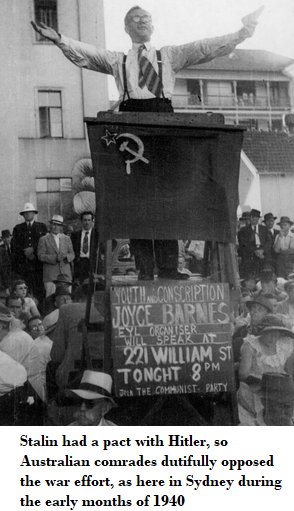
In August the Workers’ Weekly reported on five people sentenced to jail terms in Germany for listening to Moscow radio:
It’s a heinous crime in Germany today to read, listen to or even think over accounts of a country without bosses, warmongers, race-hatred, unemployment, hunger and other evil features of capitalism. To what plight has fascism reduced the German masses!
And in the Soviet Union the previous month, émigrés and citizens of German descent were automatic suspects of anti-Soviet crimes and liable to be arrested. That purge month, between August 5 and 31, 150,000 people were arrested and 30,000 executed.
When the Red Army was torn apart by denunciations, arrests and executions, the Central Committee of the Communist Party in Sydney unanimously passed a resolution “endorsing the punishment of the plotters against the Soviet government by proletarian justice and denouncing the activity of this shock troop of fascism”. Only four months previously the newspaper had published a photograph of one of the executed men, Mikhail Tukhachevsky, Vice-Commissar of Defence, proudly shown off “as the world’s most brilliant tactician”. Now Lance Sharkey referred to the tortured man as “the late and unlamented Tukhachevsky”. Ignorant as the Australians were about the full facts of what was happening in the Soviet Union, there is an affinity on their part with the violence of the Soviet system that sits uncomfortably with the humanistic causes they opportunistically espoused.
In Stuart Macintyre’s The Reds (1998), a book which won an award from a Left newspaper, he excuses Australian communists of their revolutionary mission of wanting to kill lots of us, as communists did in the Soviet Union:
Its revolutionary mission extended into a whole range of emancipatory projects: the abolition of sexual inequalities, freedom for Aborigines and all other colonised peoples, the removal of the White Australia policy and full acceptance of national minorities were just some of them.
In Our Unswerving Loyalty (2008) David W. Lovell rightly points out the obvious flaw in Macintyre’s argument: “it was their serious intention to make the most far-reaching social and political changes to liberal democracy based on a theory that was flawed, and that they held up as a model a regime that was systematically brutal and inhuman”. And they acted with their eyes wide open.
Other prominent Soviet citizens who featured in the Workers’ Weekly in 1937 also ended badly—sooner or later. Marshal Vasily Blyukher was beaten to death by his NKVD interrogator in 1938; Valery Mezhlauk, appointed People’s Commissar for Heavy Industry in 1937, was executed in 1938; Sergei S. Yudin, described as a noted surgeon “in the new Socialist Russia”, was arrested in 1948, tortured, imprisoned and exiled. He returned to the Soviet Union after the death of Stalin and died in 1954. Mikhail Koltsov was praised as the “noted Soviet journalist and ‘Pravda’ correspondent [also NKVD agent] in Spain, whose despatches stirred the world”—he would be shot in 1940. The newspaper published an article by Soviet Finance Minister Hryhoriy Hrynko:
The masses of the people of the Soviet Union are ever more firmly consolidating around the Party of Lenin-Stalin, around the great organiser of the Socialist victories of the Soviet fatherland—Comrade Stalin.
Just over seven months later Hrynko would be sentenced to death in the last of the public Moscow trials. Even the appalling Nikolai Yezhov of the NKVD, organiser of the Great Purge, was praised when he received the Order of Lenin in September. His turn in the cellar came in November 1940.
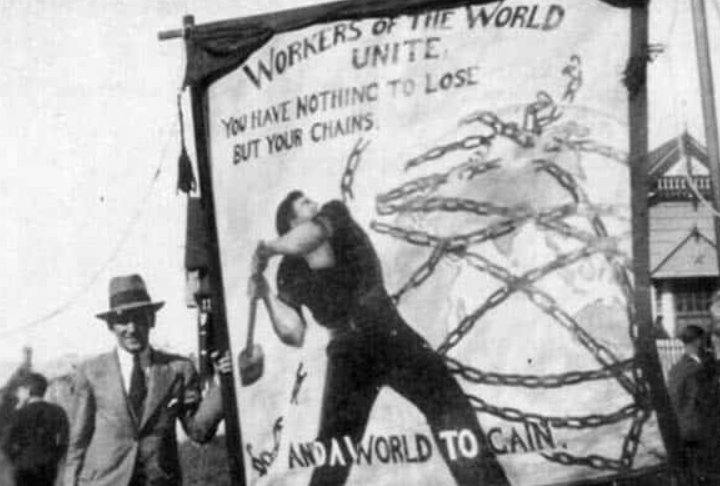
In 1937 the Red Army was decimated by Stalin, and in Australia the Workers’ Weekly was interested in our own Navy:
The highly undemocratic and oppressive treatment of the men in the Australian Navy continues to be shown by outbreaks of dissent … the men were asked to participate in the annual naval regatta to be held shortly at Hobart. As a protest the men coldly refused … Stories are reaching here [Sydney] of mysterious disturbances on some ships.
Across its issues the communists, who may have watched Battleship Potemkin too often, encouraged the sailors to “Demand democracy in the Australian Navy!” Their grievances were highlighted in a supposed complaint from a sailor: “We have to live on a mess deck with about 150 others, where the fittings could only be equalled in a convict ship under conditions that are, especially in the tropics, unfitted for human beings.” A later editorial, “Sailors! The Workers Support You!”, presented their campaign in a “Communist manner”. The Australian Navy was bad; a recruitment campaign was derided as a “Cannon-Fodder Call-Up”. The Red Navy was very good: “To match fascists a Red Navy”. And even as the Red Army was being decimated it was praised for giving its soldiers “political and democratic rights impossible in capitalist armies, even the right to criticise the officers”.
The January 1937 Soviet census was much praised in the Workers’ Weekly, where it was noted that people were not asked if they were employed: “With unemployment only a memory in the Soviet Union now, the omission of this question is eloquent testimony to the achievements of Socialism.” In March it was reported that early results from the census showed the populations of major cities “have increased even more than was estimated”. On one side were the capitalist countries where the “Falling birth rate reveals capitalist decay” and on the other the Soviet Union where “an immense annual increase in the population has been noted”. The released information from the census seemed impressive: “according to provisional figures the birth rate in the Soviet Union in the first quarter of 1937 was about 30 per cent higher than in the first quarter of 1936. The Ukraine leads the way with an increase of about 70 per cent.” Other good news, apart from more children, was that “Divorce rates have decreased by approximately 70 per cent in the Ukraine and White Russia.” Some results were simply astounding: “In Leningrad, Baku, Tashkent and other towns the birth rate has doubled.” Australia was ascribed a declining birth rate, and the Soviet Union a soaring one: “Does the Soviet system need a better recommendation?”
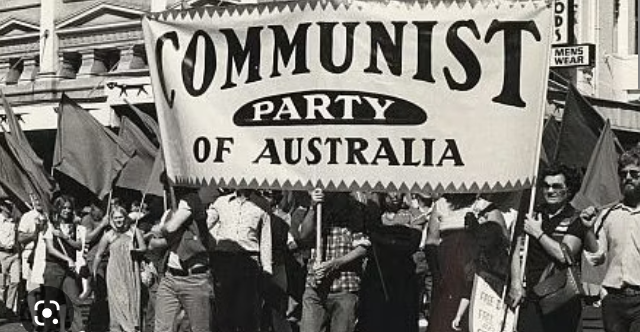
Unfortunately the real figures in the 1937 census were disastrous and revealed a population decimated by famine, deportations, executions. It was a demographic catastrophe. Based on projections made from the previous 1926 census, millions had disappeared. The highly praised census vanished and would only be revealed in Soviet archives in the 1990s. The errors in the accounting were corrected in the usual way. Arrests and executions of those associated with the census had began as early as March while it was being praised in Sydney.
A local expulsion from the Party was covered in the Workers’ Weekly. It concerned the American-born communist Frank Nathaniel Wiggin (1883–1964) who was excluded for “misuse of Party funds, gross bureaucracy in his financial dealings, and indulging in threats against the Party after realising he could no longer cover his tracks … Every Communist will completely break with Wiggin and his future associates—District Secretariat (Sydney).” Not mentioned in the published report was that he had been running an illegal betting operation to raise funds for the Party and, the real crime, had been skimming from the profits for himself. In Stuart Macintyre’s Reds is a statement of Jack Miles, General Secretary, from the files of the Special Committee to investigate the matter: “We realise that the statement must be careful. We are not yet in the USSR and not yet the ruling party and cannot handle this the way they handle Trotskyists in the Soviet Union.” When Wiggin defended himself he was described as using a “typical Trotskyist argument”.
Wiggin is not the only one who would have been shot in 1937 if the Party had been in power. Sharkey and Co had an utter loathing for “Solomon Brigg”, a commentator in the ALP’s Labor Daily. Brigg was the pen-name of Alfred Cornwallis Paddison (1901–1981), a Sydney schoolteacher who was an insightful and determined critic of the Soviet regime, always prepared to discuss the purges and remind readers of the bloody history of the regime. He 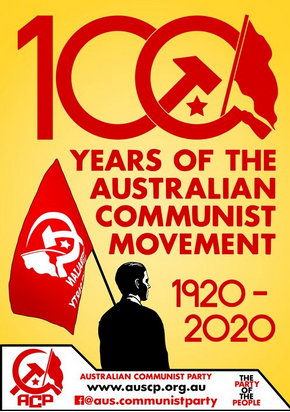 attracted some lively communist criticisms: “The Lies of Solomon Brigg … That infamous mental prostitute Solomon Brigg is at it again … contemptable fascist liar”; “It’s about time that ALP workers put an end to Solomon’s anti-Soviet filth in the columns of their official organ”; “Solomon (Paddison) Brigg has mental lumbago … a pro-fascist scribbler”. When Brigg published an article headlined “Where is Radek?” (one of the more famous victims of the first Moscow show trial), the Workers’ Weekly gave their answer: “Answer: in gaol. Supplementary remarks: Without mentioning names, there are one or two others who ought to be there too.”
attracted some lively communist criticisms: “The Lies of Solomon Brigg … That infamous mental prostitute Solomon Brigg is at it again … contemptable fascist liar”; “It’s about time that ALP workers put an end to Solomon’s anti-Soviet filth in the columns of their official organ”; “Solomon (Paddison) Brigg has mental lumbago … a pro-fascist scribbler”. When Brigg published an article headlined “Where is Radek?” (one of the more famous victims of the first Moscow show trial), the Workers’ Weekly gave their answer: “Answer: in gaol. Supplementary remarks: Without mentioning names, there are one or two others who ought to be there too.”
Public celebrations in the Soviet Union in 1937 included the opening of Moscow–Volga canal. The slave-labour project overseen by the NKVD in which tens of thousands of prisoners died was highly praised by the Workers’ Weekly, which was at the same time campaigning for a forty-hour week for Australian workers. On the canal’s completion the newspaper noted that 50,000 prisoners were freed: “during their ‘imprisonment’ they received regular wages, enjoyed full facilities for sport, study and cultural activities, and so on. Compare with the prison system in Australia. It’s the difference between day and night, or more to the point between Socialist and capitalist countries.” As Karl Schlögel later wrote in Moscow, 1937, there was something they did not know about the jubilant Moscow reports of the opening ceremony:
They failed to mention that the completion of the building works and the release of the prisoners coincided almost exactly with the arrest of the managers of the canal project and the camp and their detention in the canal zone … an eyewitness on board one of the boats in the flotilla at the opening of the canal, saw some of the bosses of the construction project being forced off the boat and into black limousines on their way to the Lubyanka.
Some months later the Workers’ Weekly had a headline, “Where Jobs Hunt Men—Meaning the Soviet Union. When the 55,000 former convicts working on the now completed Moscow–Volga canal were released, offers of 165,000 jobs poured in. Three jobs to a man!” This may refer to a different batch of 55,000 men who were released by government decree in July to act as “shock workers”. At the time the Workers’ Weekly was supporting a local campaign to instal windscreen wipers on Sydney trams.
In July the newspaper reported on a successful sit-down strike by unionist sewerage workers in Sydney to reinstate a representative: “the men had been sitting for three or four hours”. But they did not report the introduction of the “strictly confidential” NKVD Order No. 00447 which signalled mass terror across the Soviet Union and introduced killing by quota systems. It was an order that was only revealed in the early 1990s, and changed historians’ views of 1930s Stalinism and the mass purge that had been carried out.
As the Soviet Union celebrated the twentieth anniversary of its “revolution”, terror had been unleashed across its entire territory. On the subject of the anniversary the Workers’ Weekly became poetic: “While Mussolini yelps like a mad dog that ‘Bolshevism must be kept out of the Mediterranean’, the spirit and meaning of Bolshevism is filtering through the nations like a fragrant incense.” A celebratory rally was held in the Sydney Domain and the speech by Jack Miles was reported:
In the Soviet Union where all people were already well-to-do, the way of the Communist Party in achieving Socialism had been correct … That morning [of the Communist Revolution] had introduced religious freedom to the peoples of the Soviet Union transcending the freedom given to religious convictions in the capitalist countries.
During the Great Terror this religious freedom was a bullet in the neck for members of the clergy.
The Soviet national election on December 12 was the next high point in the Soviet year to be celebrated. The night before the voting took place, Stalin concluded his election campaign with a speech in the Bolshoi Theatre. As he acknowledged the applause, 127 victims of his terror were being executed at the Butovo shooting range. Butovo, on the city periphery, was one of the major execution sites throughout the Great Terror, with almost daily mass executions—four nights previously 474 people had been shot. Though the election results were not unexpected, the Workers’ Weekly expressed surprise and wrote a love letter to a dictator: “Everyone voted for Stalin! … Joseph Stalin, greatest living man of our time, has been returned for his Moscow constituency by a 100 per cent vote of the electors.” This was the future the Australian Communists desired for Australia and these were the people who would have killed their way to the bright future they foresaw.
Further reading. The German historian Karl Schlögel’s Moscow, 1937 (2012) is a fascinating account of the year and the city of Moscow, using sources imaginatively to tell the story. Anything by the French historian Nicolas Werth on the Show Trials and Terror(s) is good; his text in The Black Book of Communism (1999) is a good place to start. For French readers his L’ivrogne et la marchande de fleurs (The Drunk and the Flower Seller) is excellent.
 Sign In
Sign In 0 Items (
0 Items ( Search
Search









John Littlepage, in his In Search of Soviet Gold (1939), gives an eyes wide-open but with careful phrasing picture of instances of some of his colleagues, senior engineers, scientists and bureaucrats, being branded as saboteurs or wreckers and disappearing. Even though Stalin had recognised the utopian folly of Lenin’s dismissal of the usefulness of foreign currency he apparently never resiled from his view that his reign of terror was primary ‘revolutionary’ tool.
Thank you, Michael.
And not forgetting how the Workers’ Weekly reported aboriginal affairs in 1931, in terms then unusual but strangely reminiscent of orthodoxy since the 1980s:
“Not only are inhuman exploitation, forced Labor and actual slavery forced upon the Aborigines, but a campaign of mass physical extermination is being and has been carried on against them, until to-day less than 60,000 full bloods have survived the murder drive … setting up organisations of crawlers and kidnappers, known as “Aborigines Protection Boards” to enslave the remaining members of the tribes, and “Mission Stations,” under dope-peddlers to muster the youth so that they can be sold into slavery ” … “cyanide in the meat, and strychnine in the flour, police shooting parties, burning the bush over their heads, segregating sexes, kidnapping the children” etc etc
https://trove.nla.gov.au/newspaper/article/209418403
In 1956 Khruschev’s revelations arrived about Stalin’s murderous ways. Local Pary bigwig Eric Aarons wrote in his autobiog What’s Left? (p118), of 1993:
“…I made the point at the Central Committee [of the Australian Communist Party] meeting which decided the matter that our outlook was such that, had we been in power, we too could have executed people we considered to be objectively, even if not subjectively (that is, by intention), helping our enemies.
In other words, the CPA would have implemented Stalin’s same murderous policies if it got the chance, slaughtering not just ideological foes but anyone they saw fit to designate as bullet-worthy.
I had a relative in Sydney who wouldn’t hurt a fly but she was nonetheless a CPA sympathiser. I borrowed from her bookcase, and still possess, the 540-page Soviet-authorised “History of the Communist Party of the Soviet Union /Bolsheviks”, Foreign Languages Publishing House, Moscow 1951, price three shillings and sixpence. Nearly all its prose is bureaucratic sludge-dogma, but the final pages of the final Chapter 12 (1935-37) seem to bear the personal writing of Stalin himself. It’s headed: “Liquidation of the Remnants of the Bukharin-Trotsky Gang of Spies, Wreckers and Traitors.” The author writes of those “dregs of humanity”, “Whiteguard pygmies”, “insects”, “contemptible lackeys of the fascists” and “useless rubbish” who had been in the pay of Westerners and Japanese for 20 years with the goal to “restore capitalist slavery in the USSR.” We learn that “The Soviet court sentenced the Bukharin-Trotsky fiends to be shot. The People’s Commissariat of Internal Affairs carried out the sentence. The Soviet people approved the annihilation of the Bukharin-Trotsky gang and passed on to the next business.” QED, as my geography teachers used to say.
Stalin, perhaps, could be excused (I’m not serious) because of his blinkered world-view but what can be said for Western academia:
.
“Marxism is problematic because, in its nonfalsifiabilty, it cease to be a heuristic device, useful for selecting and interpreting evidence, and is a more all-embracing ideology, a Procrustean bed, an a priori system that simply discounts or reinterprets any evidence that might call its fundamental veracity into account. So how can this be of use to historians.
. . . .
Ironically, as regards [Christopher] Hill, I saw this flaw most dramatically (and tragically) in a BBC documentary some years ago. The program was examining the fascination of British intellectuals, such as George Bernard Shaw with Stalin and communism in the 1930s . . . . . the interviewer asked Hill, what about the famines caused by Stalin’s economic policies in the 1930s? I will never forget the great historian’s answer: there were no famines. What about all the evidence? responded the somewhat startled interviewer. There is no evidence, said Hill, and any that you claim to provide is merely manufactured misinformation of those imperialist Westerners who wish to hide the glories of what communism has done and can do.
.
The answer was stunning because Hill was an Oxford historian, a man who made his living by interpreting the past on the basis of empirical evidence. What it showed was that his commitment to Marxist philosophy trumped his commitment to allowing the evidence to shape his thinking; indeed, when push came to shove, his Marxism led him to sound as delusional as the typical black helicopter aficionado from the craziest corners of the virtual world.”
.
Carl R Trueman Histories and Fallacies 2010 pp. 97-105
Alexandr Solzhenistyn’s summation of Stalin’s world view:
“The Great Ruler, aroused by great thoughts, strode mightily about his night study. Music swelled within him; an enormous brass band provided the accompaniment to his march.
.
Discontented, eh? Let them be! They always had been discontented, and they always would be.
.
But Stalin had a passing acquaintance with an uncomplicated version of world history, and he knew that given time people will forgive all bad things, indeed forget them, or remember them as good. Whole nations behaved like Queen Anne in Shakespeare’s Richard III : Their wrath was short-lived, their will infirm, their memory weak, and they would always be glad to give themselves to the victor.
. . . . . . .
The reason why he had to live to ninety was that the struggle was not over, the building was not finished, the times were uncertain, and there was no one to take his place.
.
He must wage and win the last world war. Exterminate like gophers the Western Social Democrats and all the persistent pests throughout the world. Then, of course, he must raise the productivity of labour. Solve all those economic problems. In short, build Communism, as the phrase went.
.
In that context, by the way, completely incorrect ideas had entrenched themselves. Stalin had thought it over recently and reached clear conclusions. Naïve and short-sighted people pictured Communism as a kingdom of plenty, of freedom from necessity. But that would be an impossible social order, at that rate Communism would be worse than bourgeois anarchy! The first and main characteristic of true Communism must be discipline, total subordination to authority, and strict execution of orders. (The intelligentsia must be kept under particularly firm control). Second, “plenty” must be modest plenty, not even sufficiency in fact, because over-prosperous people fell into ideological disarray, as could be seen in the West. If a man does not have to worry about food, he escapes the material pressure of history, being ceases to determine consciousness, and everything is topsy-turvy.
.
So, when you came to think of it, Stalin had built true Communism already.
.
This could not, however, be announced, or people would be asking, Where do we go next?
. . . . . . . .
Obviously it would never be possible to announce that the Communist society had been built. That would be a methodological error.”
Alexandr Solzhenitzyn In The First Circle (2009) pages 144-5
I am fairly sire that this observation would not have appeared in the better known The First Circle, written in 1955-58 and first published in 1968 in a self-censored form.
‘Liberalism’ was a very strong boo-word in Bolshevik circles. Yet any society worth having must be founded on it,
It is absolutely essential. Yet not all would agree, even today, whether on the Left or the Right.
For anyone who has read and been shocked by Orwell’s fictional ‘1984’ & ‘Animal Farm’, they are tame stuff compared to Alexander Orlov’s ‘The Secret History of Stalin’s Crimes’ published in 1954 (and sadly out of print).
Orlov had served the regime faithfully as a counter-intelligence chief and as a Soviet Diplomat during the Spanish Civil War. He had been a friend and loyal supporter of Stalin since 1924, but now realised his recall to Moscow in 1938 was to facilitate his (and his family’s) execution as he had been party to the lost war in Spain. He fled to Canada, where he was hunted for the next 14-years by assassins.
When he was sure his parents were dead (hopefully of old age) he wrote his devastating book.
It is not over and never will be while the psychopathic Communist ideology continues to be promoted by universities and admired by our youth. in fact it continues to recur in the genocides of Mao, Pol Pot, Xi, Kim and the WEF (with its population reduction objectives).
The enemies of mankind are stronger now than they have been for 70-years.
They said they preferred ‘prison in Russia to freedom in Germany’!”
.
Quite a contrast to my first Father-in-law, a Russian who walked from Russia to Germany because he’d “rather die in Germany than live in Russia”, or so I was told.